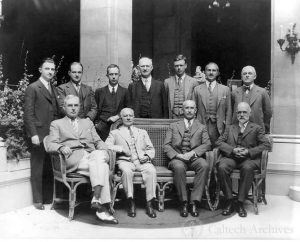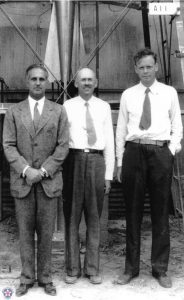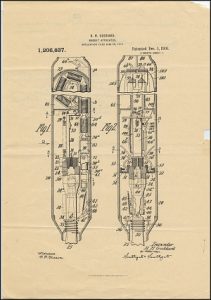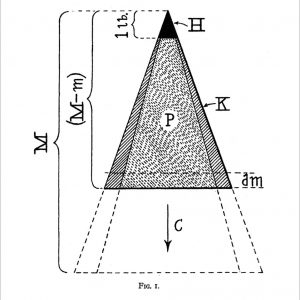A Tribute to the Father of Modern Rocketry.
On the 50th anniversary of the Apollo 11 lunar landing, the Conservancy celebrates Dr. Robert Goddard, whose invention of the liquid-fuel rocket in 1926, underwritten by the Daniel Guggenheim Fund for the Promotion of Aeronautics, propelled the United States space program for decades to follow.
This original exhibition, open daily in Castle Gould’s Club G, is comprised of archival photos of the space travel pioneer and his early rockets; it reveals the tremendous impact that Goddard had on future space travel and profiles his pivotal relationships with Daniel and Florence Guggenheim and their son, Harry, and Charles Lindbergh.
Goddard was the first scientist who not only realized the potentialities of missiles and space flight but also contributed directly in bringing them to practical realization. Goddard had a rare talent in both creative science and practical engineering. – NASA.gov

Board Meeting of the Guggenheim Fund for the Promotion of Aeronautics at Hempstead House, 1928
Seated L-R: John D. Ryan, Daniel Guggenheim, Orville Wright, W.F. Durant
Standing L-R: J.W. Miller, F.T. Davison, Elihu Root, Jr., H.I. Cone, Charles A. Lindbergh, Harry F. Guggenheim, Robert A. Millikan Photo by Mason, Port Washington, NY
The Guggenheim Family had an immense impact on the development of aeronautics and space travel as the primary sponsor of two of the greatest figures in these fields: the legendary aviator Charles A. Lindbergh and the father of modern rocketry Dr. Robert H. Goddard, whose ingenuity resulted in over 200 patents and a means to reach outer space.
The Daniel Guggenheim Fund for the Promotion of Aeronautics was established by Daniel Guggenheim and his son, Harry F. Guggenheim, in June 1926; in the following four years, the Fund provided $3 million in grants to establish schools and research centers at New York University, Stanford University, Massachusetts Institute of Technology, Georgia Institute of Technology, Harvard University, and California Institute of Technology, among many others.
 With Lindbergh as his advocate, Goddard secured financing from the Fund as well as the Daniel and Florence Guggenheim Foundation for his groundbreaking rocketry research. Following Daniel’s death in 1930, his widow, Florence, and Harry continued to support Goddard’s experiments in Roswell, New Mexico and at Clark University in Worcester, Massachusetts, where Goddard taught and conducted research. The Guggenheims were Goddard’s primary funder throughout his rocketry career, at a grand total of $183,500. Ironically, Daniel, Florence, and Harry did not see a single Goddard rocket take flight.
With Lindbergh as his advocate, Goddard secured financing from the Fund as well as the Daniel and Florence Guggenheim Foundation for his groundbreaking rocketry research. Following Daniel’s death in 1930, his widow, Florence, and Harry continued to support Goddard’s experiments in Roswell, New Mexico and at Clark University in Worcester, Massachusetts, where Goddard taught and conducted research. The Guggenheims were Goddard’s primary funder throughout his rocketry career, at a grand total of $183,500. Ironically, Daniel, Florence, and Harry did not see a single Goddard rocket take flight.
In 1948, the Daniel and Florence Guggenheim Foundation established centers for research in jet propulsion at Princeton and Cal Tech with two endowed Robert Goddard professorships. Created to encourage the development of rocket engines, the center at Cal Tech became the NASA-affiliated Jet Propulsion Laboratory, which pioneered United Stages space exploration from the 1970s on.
The Guggenheim grants were extraordinarily generous. They showed vision, courage, and amazing confidence in Goddard as an individual. – Charles Lindbergh
In 1961, NASA established the Goddard Space Flight Center in Greenbelt, Maryland as its first space flight complex. Goddard’s widow, Esther, was present at the dedication ceremony on March 16, 1961 – 35 years to the day after he launched his first liquid-fuel rocket on his Aunt Effie’s farm in Massachusetts. Today, the center studies the Earth, Sun, Solar System, and Universe on a $5.2 Billion annual budget.

ABOUT DR. GODDARD
Dr. Robert Hutchings Goddard, born in Massachusetts in 1882, was a fearless visionary – an accomplished physicist whose legacy powers all modern space travel.
At 16, he saw H.G. Wells’ sci-fi classic “The War of the Worlds” and began to imagine space travel. Twenty years later, he believed the implausible trip to outer space could be achieved through his invention of the liquid-fuel rocket. He was correct.
Before 1920, he had developed most of the basic concepts in rocket and jet propulsion, and, by 1926, he had designed, built, and launched the world’s first liquid-fuel rocket. Championed by Charles Lindbergh, Goddard’s genius was recognized and supported by Daniel Guggenheim and his son, Harry, as well as the Smithsonian Institute. In addition to his research, the Guggenheim’s sponsored Goddard’s move from Worcester, Massachusetts, where his rocket launch trials frightened his neighbors, to the open expanses of Roswell, New Mexico – and back again to Clark University, where he taught and conducted his research.
Goddard’s greatest engineering contributions were made during the 1920s and 1930s. He was awarded more than 200 patents in rocket technology, most after his death in 1945, as well as a Gold Medal from the 86th Congress in 1959. His inventions formed the basis for the United States space program, and made possible a nation’s dream of travel to the Moon, Mars, and beyond.
HIGHLIGHTS OF DR. GODDARD’S MAJOR CONTRIBUTIONS:
- Explored the practicality of using rocket propulsion to reach high altitudes – even the moon (1912)
- Received patent for two- and three-stage rockets (1914)
- Proved that a rocket will work in a vacuum, a rocket does not need to push against no air
- Developed and fired a liquid fuel rocket (1926)
- Shot a scientific payload in a rocket flight (1929)
- Used vanes in the rocket motor blast for guidance (1932)
- Developed gyro control apparatus for rocket flight (1932)
- Developed pumps suitable for rocket fuels
- Launched a rocket with a motor pivoted on gimbals under the influence of a gyro mechanism (1937)
– NASA.gov
WHERE IT ALL BEGAN…
 Dr. Goddard’s patent drawing of rocket apparatus, 1916
Dr. Goddard’s patent drawing of rocket apparatus, 1916

Dr. Goddard’s sketch for his “Method of Reaching High Altitudes” theory, 1945
- August 31, 2019 - July 31, 2020
12:00 pm - 5:00 pm
Location
Venue: Castle Gould
Address:
Directions to the Sands Point Preserve
Directions from NYC: Long Island Expressway to exit 36 (Searingtown Road/Port Washington). At the light, make a left and go under the Long Island Expressway heading north. Take Searingtown Road north, it will change into Port Washington Boulevard and then into Middle Neck Road. The Preserve will be on the right.
Directions from points east: Long Island Expressway to exit 36 (Searingtown Road/Port Washington). At the light, make a right onto Searingtown Road. Take Searingtown Road north, it will change into Port Washington Boulevard and then into Middle Neck Road. The Preserve will be on the right.








